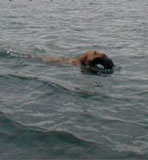| Contact us |
| Try wildfowling |
| Club merchandise |
| Wildfowl art |
| Wildfowling books |
| Join KWCA |
| Search |

The first retrieve
by Alan Jarrett
Increasingly stringent wildlife and habitat regulations may threaten to
restrict our sport more and more, but there is the not insignificant spin-off
that they have also put a firm brake on the loss of habitat for a host
of uses. Admittedly the parlous state of agriculture in general has also
been of assistance in this respect, so that the two factors together mean
land use is now less likely to change for the worse.
The great marshland tracts along the southern shore of the Thames estuary
in former times stretched almost unbroken for some 22 kilometers. Some
was lost to drainage and conversion to arable, but the great majority
still remains so that by any measure the marshland appears at times endless.
Certainly a day out on these marshes remains a treat: double so when a
good wind blows, and even in the early part of the season there is a hint
of the chill winds to come a few months hence. A wind strong enough to
bend the phragmites almost double and send thistle seed hurrying across
the marsh in tightly drawn clumps is inspiration enough for any man.
WALK
The walk for rabbits is a curious mix of delight and disappointment. Delight
to bowl over a dashing quarry, but disappointment to find that it carries
the scars around the eye of an animal recently recovered from the scourge
disease which has afflicted the species for two generations. There is
of course a mix of clean and infected animals, which makes the infection
all that more curious.
The other oddity on these marshes is the varying water levels. Ditches
and pools which are apparently at the same level hold water to varying
degrees – some being knee deep and more, whilst others may be a dried
out mess of mud and rotting vegetation.
For the walking gun it is the near-dry areas which excite the most interest,
for it is here that snipe may be found. Never an easy target under such
circumstances the speeding birds takes every advantage of the wind to
outwit the Gun time and again.
The neighboring Gun indicated snipe ahead, which he had seen flutter down
into a ditch and by hurrying ahead and waiting in a near-dry offshoot
I had the most marvelous chance at a ‘scrapping’ bird hurtling
past with the wind. It fell some eighty yards away into some standing
water, from where both dogs competed for it – as usual the older
of the two brought back the prey.
This is a common occurrence when running an older dog alongside a youngster.
The youngster seldom gets a look in, until as experience in one overtakes
failing legs in the other and the roles become completely reversed. This
then is the saddest part of the older dog slipping past its prime, and
the vibrant youngster takes over the major share of the work.
FLIGHT
Sitting for evening flight early in the season can be a lengthy, yet pleasant,
experience – especially when there is enough wind to keep the mosquitoes
at bay. Sadly the snipe come so late that it is quite impossible to see
them until the last moment, and in that same moment they are gone! The
duck are very sparse, and a long time in coming.
Yet every flight – every venture onto the marshes or the shore –
is an adventure of sorts. On this day there were two events which will
perhaps never fade.
Some twenty yards to my right was a small disused duck hide made from
stakes and corrugated iron; too far back from the edge of the pool to
get the best of the shooting, whilst its iron construction makes it completely
incompatible with steel gun barrels! Here I had left dead rabbits, a snipe,
a teal and a carrion crow – the fruits of the previous few hours’
work.
The faintest of movements betrayed a fox no doubt homing in on the scent
of the slain. It passed between the old hide and me and I suspect we saw
each other at the same moment; then it was away over the low bank to my
rear and into the deep gloom that had now enveloped the marsh. My awkward
position and the gloom no doubt saved it from joining that pile of the
slain.
Later, with the light desperately poor, I flicked a teal down into the
field to engender a frantic two dog race for the fallen. Eventually the
older dog returned with the little bird and I called in the youngster
– but she already stood before me positively oozing pride at here
first ‘real’ retrieve.
The normal fussing ensued, whilst the older dog eventually returned looking
somewhat chastened. We all three sat awaiting more birds which did not
come.
Another adventure was over.